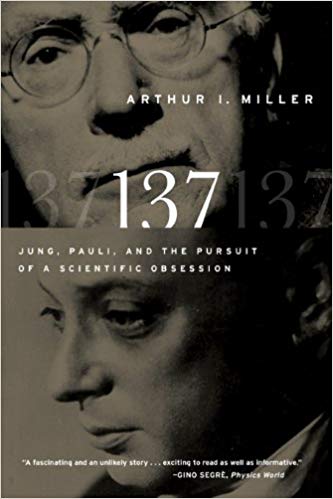
We’ve written about the #137 and Wolfgang Pauli previously, but now we have a somewhat disconcerting update.
This comes from the dog park, where we met a recent graduate of Virginia Tech who has a degree in physics. Trish and I know know nothing about the math side of physics, but we can talk generally about the mysterious nature of quantum physics. We tried the #137 on the new grad and it was surprisingly meaningless to him. He also didn’t seem to recognize Pauli’s name F. David Peat, another physicist now better known for his exploration of synchronicity. I guess we’re doing woo-woo physics!
In case our new friend sees this post, here’s a better explanation of Pauli and 137.
Wolfgang Pauli, a physicist, won a Nobel in 1945 for his exclusion principle. He was an early supporter of Jung’s theory on synchronicity and investigated the phenomenon as well. He had a rather striking experience with a set of numbers that lasted for most of his adult life.
Pauli was confounded by one of the unsolved mysteries of modern physics, the value of the fine structure constant, which involves the number 137. “The fine structure constant is one of those numbers at the very root of the universe and of all matter,” writes Arthur I Miller in Deciphering the Cosmic Number: The Strange Friendship of Wolfgang Pauli and Carl Jung. “If it were different, nothing would be as it is.” As Miller explains in his fascinating book, 137 is not only the “DNA of light” but also the “sum of the Hebrew letters of the word ‘Kabbalah.’ The fine structure constant turns out to be exquisitely tuned to allow life as we know it to exist on our planet.”
Heady stuff, even to non-scientists. 137 is a prime number—a number that can be divided by 1 and by itself. Or, put another way, a prime number is a positive integer that cannot equal the product of two smaller integers. The number became so puzzling to physicists that the famed Richard Feynman, who won the Nobel Prize in 1965 for his contributions to the development of quantum electrodynamics, said that physicists should put a sign in their offices to remind themselves of how much they don’t know. The sign would be simple: 137.
In 1934, Pauli began discussing his ideas publicly about 137 and Miller speculates that it might have been due to the effect of Jung’s analysis “opening his mind to mystical speculation.”
As physicist and author F. David Peats explained, “…while the other fundamental constants of nature are all immensely small or enormously large, this fine structure constant 1/137 turns out to be a human-sized number. This number…and its place in the scale of the universe particularly puzzled Pauli.”
It’s always interesting the people we meet in the dog park. But the odd thing is, in this instance and others, I often remember the dog’s name, but not the person. The young V. Tech grad’s dog was called Fabor. Not sure why he gave the dog that name, but here’s what Fabor means in the Urban Dicitionary.
“Know what? Go FABOR.”








Perhaps the dog is holier than thou and never, ever wrong. I try to never underestimate an animal.